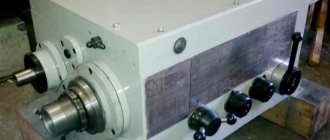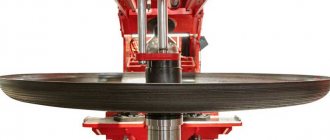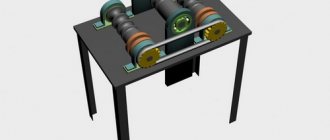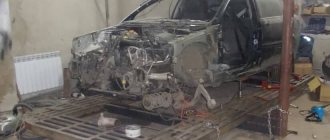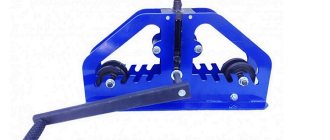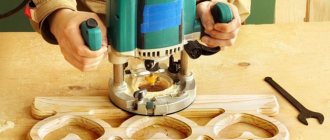The article describes in detail how to make a wood milling machine with your own hands with all the details of the working platform - bed, tabletop, base plate, additional protective devices. Step-by-step technologies for converting a drill and washing machine engine into a milling machine are presented, as well as the main points of manufacturing a machine with numerical control.
Preparing to make a milling machine
When planning to make a wood router with your own hands, you should proceed from the basic principle. It is better to immediately install the cutting attachment of the machine so that it can process wooden workpieces not only along straight contours, but also along curves. This will be needed for shaped sharpening of edges and making complex grooves. The type of router depends on the tasks being solved.
- For figure cutting, a manual milling machine with a movable cutter, which is attached to a spindle fixed to the shaft, is suitable. The movement of the cutter is provided by a motor placed in the housing.
- Plunge-type milling machines are used to make holes of the required depth.
Plunge router
- A stationary milling machine will allow you to obtain a more complex recess and pattern on a wooden workpiece. In addition, work time is saved compared to hand tools.
Important! For periodic processing of workpieces in small quantities, a manual milling machine is sufficient, but it is better to entrust regular work with large batches of lumber to a stationary tool.
What is a homemade drill machine?
In this case, a hand drill (or screwdriver) will act as a drive for all equipment. You will need to clamp a drill or cutter into the chuck, which will be used to process the wood. The body of the drill on a homemade device is mounted on a base or a special mechanism, with the help of which the cutting part of the device can be positioned in the desired direction relative to the workpiece.
The operating principle of a homemade product will differ little from the factory version. The home design resembles the elements of a standard device, not made in handicraft workshops. The only exception is that the drill mounting parts are made independently, and the design of the unit itself will depend on the material that needs to be processed.
If you have to perform simple operations with a milling cutter, then there is no point in making a complex device, so you can use a minimum number of components.
For reference! If the need arises, you can always modify the unit by making a more complex design. It all depends on the capabilities of the master, as well as his needs.
General arrangement of a workplace for a milling machine
The working platform for milling typically consists of the following structural elements:
- bed;
- Workbench;
- table top;
- machine frame;
- drive support platform;
- directly milling machine;
- spindle for securing the cutter;
- spindle launch panel;
- slides that ensure the movement of the workpiece;
- management control system.
General arrangement of the workplace
Types of unit
There are many types of milling equipment, each of which has its own distinctive design features and purpose. Conventionally, devices can be divided into several types.
Machine tool with numerical program device
The design of this type of device has a built-in microprocessor with a certain amount of RAM and an operating system. Thanks to this, it can be programmed to perform a certain sequence of operations and configure the functions of the device.
The advantages of running a CNC machine are as follows:
capable of performing several types of operations simultaneously;- allows you to save costs on labor costs and organizing the production process;
- increasing the level of labor productivity;
- reducing the time required to complete a task.
To work with this type of milling device, you must have special skills and knowledge.
Engine requirements for a milling machine
The main parameter of the electric motor for the future router is power. It is recommended to install the motor at 1100-1200 W. For simple wood processing, 400 W is enough, but higher power will allow you to work with different types of cutting attachments, that is, expand the capabilities of the tool. A three-phase asynchronous motor from a drill, hammer drill, or grinder is suitable.
Three-phase asynchronous motor
Engine speed from 10 to 35 thousand rpm. Insufficient frequency will lead to poor sharpening; excessive frequency can lead to overheating and even fire of the wooden workpiece.
As for power supply, homemade home routers are connected via a standard 220 V network. It is worth equipping the machine with a power cable with a cross-section sufficient for the engine power.
Important! It is recommended to equip the milling machine with a switch for soft start and quick stop modes. The motor is designed so that the motor brushes can be changed without disassembling the housing.
Step-by-step procedure for assembling a working platform for a wood milling machine
The standard sequence of stages for making a working platform for a wood router with your own hands:
- Construction of the bed.
- Installation of workbench and tabletop.
- Drilling a hole for the base plate to drive the router.
- Manufacturing of one side and two comb stops.
- Connecting the dust collector to the vacuum cleaner.
- Additional protective elements
- Installing the wood router into working position.
- Connecting to the network, checking operation.
Milling table bed
The first thing to construct is the frame - a frame for the milling table. It is made of metal or wood, depending on the material and dimensions of the future workpieces. Type of construction: prefabricated or cast. The primary requirement for the bed is high stability while working with a router.
The metal frame is designed as follows:
- Using a grinder, pieces of corner profiles or pipes of the required length are cut and welded together.
- At a height of 15-20 cm from the floor or other supporting surface, transverse jumpers are welded for greater stability.
- Support plates are welded to the upper ends of the vertical pipes.
- Threaded holes are made in the plates for bolts to fix the future table.
Idea! Instead of a profile, you can use adjustable supports. This will allow you to install a bed for a homemade router even on a not-so-even surface.
Stand with adjustable legs
Milling table
The entire milling process is carried out on a special table, better known as a workbench. Its dimensions depend, first of all, on the area of the workshop, and secondly, on the volume of work. There are three types of workbenches for a milling machine:
- Static – installed in one place as a full-fledged working platform;
- Portable - a table that is easy to assemble and disassemble, which can be taken for on-site milling operations;
- Aggregate – used in spacious rooms.
A portable milling workbench, despite being easy to transport, is only suitable for processing small parts. It is recommended to work with a static table.
Tabletop for router
To make a tabletop for a router, as a rule, dense laminated plywood with a thickness of at least 1 cm is used. Another option is a 2.5 cm sheet of chipboard with polymer protection on top and at the ends. The protective layer, in addition to its direct function, also reduces vibrations during operation. Recesses are drilled into the sheet into which metal profiles are placed.
A used countertop from a kitchen set will do, as long as it does not have the slightest irregularities, nicks, or distortions. This will not only create unnecessary vibrations, affecting the quality of the milling, but can also damage the cutting attachment of the router.
Drive base plate
A rectangular opening is drilled in the center of the tabletop into which the base plate for driving the router will be mounted. To make the machine vibrate less during operation, it is recommended to make the recess round. The main thing is to make sure that the stove and the motor do not come into contact with each other. There should be a gap of at least 1 mm.
Drive opening
The base plate is made from at least 5 glued plywood sheets, but more often from textolite with a density of at least 1.5 cm. The plywood should first be treated with a vibration-absorbing agent. The milling machine is attached to the base plate with long motor bolts, onto which washers with rubber gaskets are additionally placed. Thanks to this, the cutting attachment will move up and down.
Side stop
It is also necessary to make a static side stop with a dust collector socket. Material - a sheet of plywood with a thickness of at least 2 cm. 3-5 holes are drilled in the table for the comb and lifting stop. The first 2 holes should be made at a distance of 0.5 cm from the edges of the rectangular recess for the cutter, the next ones - 2.5-3 cm from the first. The position of the stops depends on the size and quality of the workpiece material. To regulate the slight lateral movement of the cutter, the stop is turned and secured with a clamp.
Table with side support
Dust collector
Milling always produces a lot of dust and chips, so it is important to ensure timely disposal of waste. For this, a regular household vacuum cleaner is used, but you cannot connect it directly to the dust collector pipe - there is a high risk of breakage. The connection is made through an additional device - a dust collector, consisting of the following parts:
- Capacity 15-20 l. A good option is a bucket with a tight lid and snap-on latches.
- The inlet pipe has an internal diameter of up to 2 cm. Its lower end should be beveled by 45° and turned upward by 25-30°. The pipe must be installed at a distance of 1.5-2 cm from the side of the bucket.
- The exhaust pipe has a larger internal diameter - at least 3 cm. The selected end is made in the form of a cone, narrowed to 1.5-2 cm.
The operating principle is as follows. Dust from the milling cutter enters the inlet pipe, through the beveled end of which it is directed into the selection cone of the exhaust pipe. From there, low-density dust comes out into the vacuum cleaner, which will not damage the household appliance.
Principle of operation
Comb stop
So that the workpiece can be fed to the workbench from any side, the working platform for a wood milling machine is equipped with two combs - on the left and right sides. It is important that the comb is made of fine-grained wood: walnut, oak, beech. There should not be the slightest defects, knots, or mold.
The first tooth of the comb is shortened by 3 mm. It will not come into contact with the workpiece, acting as a rebound spring. Without this shortened tooth, there is a risk that the comb will break on the workpiece.
The ridges are attached to the side stop through a longitudinal groove using a bolt with a wing nut. In the non-working position, the comb is fixed with a self-tapping screw also on the side stop through a 7 mm hole. To transfer to the working position, the comb is placed so that all teeth, except the shortened one, touch the workpiece, and is fixed with a wing nut.
Comb stop
Additional design elements
It is also worth paying attention to the auxiliary and protective elements of the working platform for a wood router. They are responsible for the following tasks:
- work area lighting;
- Possibility of emergency stop of the milling cutter;
- protection from heavy dust;
- quick access to the mechanism for cleaning the cutting area from chips and dust.
Even at the stage of designing a tabletop for a wood milling machine, it is worth designating places for future clamps and clamps. In addition, the milling table requires guides and enclosing screens made of plexiglass with a density of at least 4 mm, which increase safety during operation. Areas of equipment that extend beyond the frame are usually marked yellow.
Another additional part of the equipment is overload protection. In unexpected cases - a milling cutter stalls, for example - the system automatically turns off the power supply to prevent machine breakdown. The spindle slows down and the drive stops.
Rule! The on and off buttons on the wood router must be installed so that they do not interfere with normal operation. The handle of the machine should be comfortable and not cause the slightest discomfort.
Required Tools
Production does not require anything special. We will prepare the necessary materials and tools for the work:
- Small grinder with a circle of 125 mm;
- A piece of I-beam 180 mm long, 20-25 cm, or a sheet of iron 5 mm thick;
- Cutting disc;
- Cleaning disc;
- Cord brush for angle grinders with metal bristles;
- Chalk;
- Vise;
- Round bit with a diameter of 40 mm for drilling holes;
- emulsion coolant;
- 10 cm of square pipe 25*25 mm and 50 cm of profile 20*20 mm;
- 2 extended nuts and 2 regular nuts with a diameter of 8 mm, 2 bolts 8*40 mm;
- A piece of sheet iron 1-1.5 mm thick;
- Chuck for drill 1.5-13 mm with threaded connection;
- Tap M14;
- Clamping bolts with wings 8*20 mm - 2 pcs., 2 nuts 8 mm.
- Drills 8 and 10 mm;
- 2 bolts 8*10 mm.

